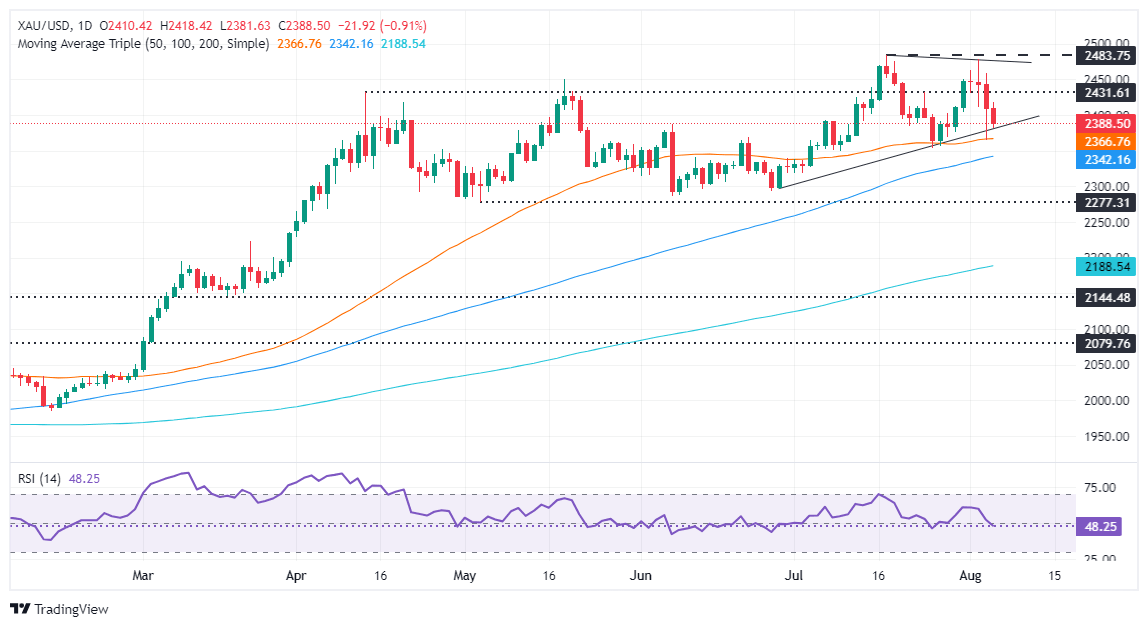Gold tumbles amid rising US yields and geopolitical worries
- Gold price dips below $2,400, trading at $2,389, extending losses for the second consecutive day.
- Rising US Treasury yields and a stronger US Dollar weigh on bullion prices.
- Geopolitical tensions in the Middle East, with Hezbollah attacks on northern Israel, could support Gold as a safe haven.

Gold price dropped below $2,400 on Tuesday, extending its losses for the second consecutive day as US Treasury yields rose amid an improvement in market mood. Rising tensions in the Middle East capped losses in the golden metal. At the time of writing, the XAU/USD trades at $2,389, down by 0.82%.
The recovery in the financial markets resumed on Tuesday, as the Nikkei recovered and closed 10% above its opening price, following Monday’s 12% plunge. Therefore, European and US equity indices posted solid gains.
Aside from this, the Greenback remains bid, a headwind for Bullion prices. The US Dollar Index (DXY), which tracks the buck’s performance against six currencies, rose 0.30% to 102.97.
Another reason for the drop in the non-yielding metal is elevated US yields. The US 10-year benchmark note coupon climbed ten basis points (bps) to 3.892%, even though traders are bracing for a 50-bps interest rate cut by the Federal Reserve at the upcoming September meeting.
Nevertheless, geopolitical woes loom after Hezbollah launched attacks on northern Israel. A conflict escalation could bolster Gold’s prospects and even pave the way for reclaiming $2,400.
On the central bank space, Federal Reserve policymakers led by San Francisco Fed Mary Daly said the dual mandate risks had come into balance and that they’re open to lower borrowing costs in coming meetings.
Daily digest market movers: Gold price on the defensive amid risk-on mood
- Worries of a US recession had faded, shown by market mood. Despite this, traders expect the Federal Reserve (Fed) will cut interest rates by 50 basis points at the September meeting.
- Market players found some relief following the ISM Services PMI release, which revealed the economy continues to expand at a healthier pace following a dismal ISM Manufacturing PMI report and a dismal US jobs report.
- A deteriorated market mood would continue influencing traders as fears of a US recession ignited a sell-off among the largest stock market indices.
- The Fed decided to hold rates unchanged last week but indicated that favorable data on inflation and further weakening in the labor market could prompt action.
- The CME FedWatch tool shows the odds for a 50 bps Fed rate cut at the September meeting were lowered from 85% on Monday to 69.5%.
Technical analysis: Gold price slumps and hovers around $2,360
Gold price slipping below $2,400 could pave the way for a break below key support levels, dragging prices towards the May 3 low of $2,277. Momentum shifted aggressively bearishly, as depicted by the Relative Strength Index (RSI).
If XAU/USD drops below the 50-day Simple Moving Average (SMA) at $2,366, this would exacerbate a drop to the 100-day SMA At 2342, followed by a support trendline around $2,316. Once cleared, the next support would be $2,300
Conversely, if buyers reclaim $2,400, the next resistance would be the psychological $2,450 mark. A breach of the latter will expose the August 2 peak at $2,477. Followed by the all-time high at $2,483 ahead of $2,500.
Gold FAQs
Gold has played a key role in human’s history as it has been widely used as a store of value and medium of exchange. Currently, apart from its shine and usage for jewelry, the precious metal is widely seen as a safe-haven asset, meaning that it is considered a good investment during turbulent times. Gold is also widely seen as a hedge against inflation and against depreciating currencies as it doesn’t rely on any specific issuer or government.
Central banks are the biggest Gold holders. In their aim to support their currencies in turbulent times, central banks tend to diversify their reserves and buy Gold to improve the perceived strength of the economy and the currency. High Gold reserves can be a source of trust for a country’s solvency. Central banks added 1,136 tonnes of Gold worth around $70 billion to their reserves in 2022, according to data from the World Gold Council. This is the highest yearly purchase since records began. Central banks from emerging economies such as China, India and Turkey are quickly increasing their Gold reserves.
Gold has an inverse correlation with the US Dollar and US Treasuries, which are both major reserve and safe-haven assets. When the Dollar depreciates, Gold tends to rise, enabling investors and central banks to diversify their assets in turbulent times. Gold is also inversely correlated with risk assets. A rally in the stock market tends to weaken Gold price, while sell-offs in riskier markets tend to favor the precious metal.
The price can move due to a wide range of factors. Geopolitical instability or fears of a deep recession can quickly make Gold price escalate due to its safe-haven status. As a yield-less asset, Gold tends to rise with lower interest rates, while higher cost of money usually weighs down on the yellow metal. Still, most moves depend on how the US Dollar (USD) behaves as the asset is priced in dollars (XAU/USD). A strong Dollar tends to keep the price of Gold controlled, whereas a weaker Dollar is likely to push Gold prices up.
Author

Christian Borjon Valencia
FXStreet
Christian Borjon began his career as a retail trader in 2010, mainly focused on technical analysis and strategies around it. He started as a swing trader, as he used to work in another industry unrelated to the financial markets.

















